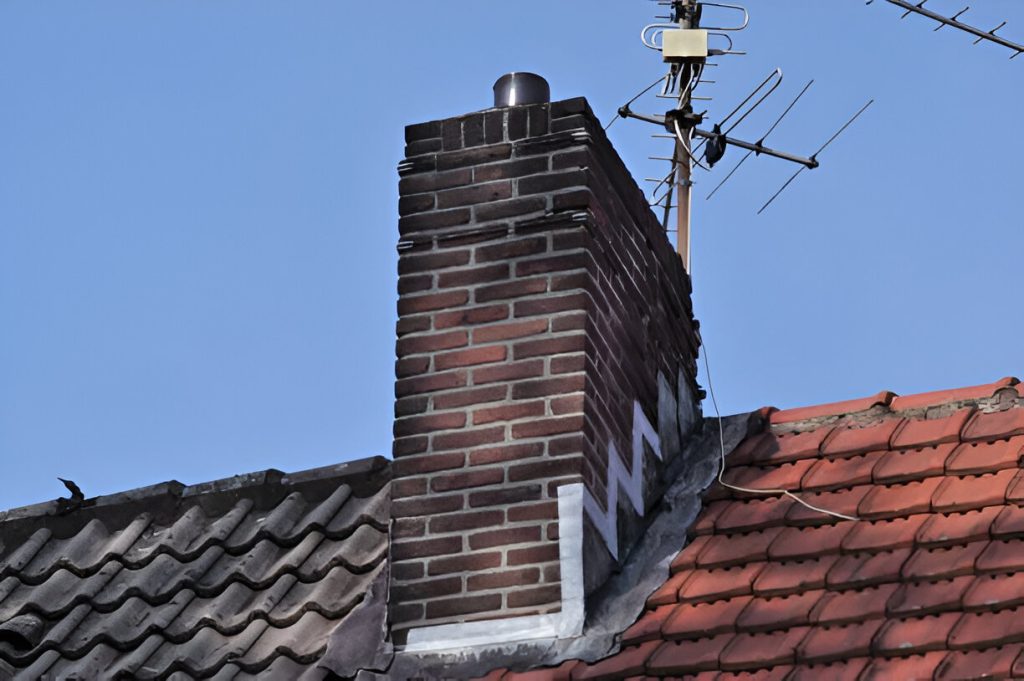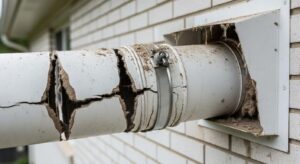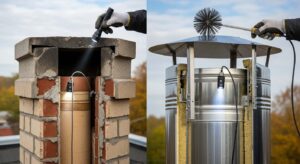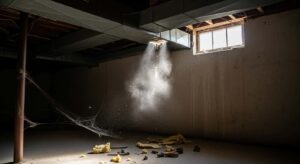Fireplaces create a warm and inviting space, but few homeowners realize how critical the chimney liner is to safety and function. A damaged or deteriorating flue liner can lead to fire hazards, toxic gas leaks, and expensive structural damage. Most people aren’t aware of what a chimney liner is, much less when it needs repair, until something goes wrong. That’s why spotting early signs of trouble is essential.
In this blog, we’ll break down the 7 most important warning signs of chimney liner trouble, explain how to handle flue or liner repair, and share practical steps to help you prevent damage before it starts.
7 Warning Signs You Need Chimney Liner Repair
Many chimney liner problems start silently, but the consequences can be dangerous if these problems are not caught early on. A damaged liner can expose your home to heat transfer, carbon monoxide leaks, and even chimney fires.
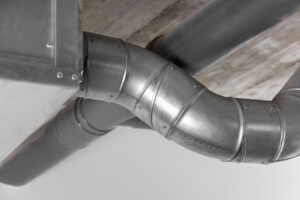
Below are seven reliable signs that indicate your chimney liner may need repair.
1. Smoke Indoors
If you notice smoke entering your home, especially while using the fireplace, it’s a red flag. A damaged or corroded liner allows smoke to escape into your living space instead of venting it outside. This issue can also lead to harmful gases like carbon monoxide infiltrating your home. Even a small amount of smoke indoors can indicate a problem that needs immediate attention to avoid serious health risks.
If left unchecked, the issue can worsen, posing greater dangers to your home and health. Ensuring proper ventilation is crucial, so consider having your chimney liner inspected by a professional as soon as you spot any signs of smoke indoors.
2. Debris in the Firebox
If you see fragments of broken clay tiles or mortar in your firebox, it’s likely a sign of liner deterioration. Traditional clay tile liners are susceptible to cracking over time, especially after repeated heating and cooling. These fragments can obstruct the chimney’s airflow, increasing the risk of a fire.
A damaged liner can’t provide the continuous protection your chimney needs, so it’s essential to address the problem quickly. Replacing the liner or repairing it will restore the chimney’s safety and efficiency.
3. Moisture or White Stains on Brick
Water stains or white powdery deposits (efflorescence) on the exterior of your chimney suggest that moisture is leaking through. A compromised liner allows water vapor to escape and soak into the masonry, weakening the structure.
Moisture not only damages the bricks but also encourages rust and mold growth, further deteriorating the chimney. Addressing the issue early can prevent costly repairs down the line. If you notice moisture around your chimney, it’s time for an inspection.
Also Read: Understanding Chimney Liner Damage: Signs You Need Repair
4. Rust on Damper or Fireplace Doors
Rust on the damper, fireplace doors, or chimney cap is another sign of moisture problems caused by a damaged liner. When the liner is cracked or corroded, water enters the chimney and mixes with combustion gases, creating a corrosive environment.
Over time, this rust can damage components like the chimney damper, preventing it from sealing correctly. A compromised damper affects your chimney’s efficiency and can cause smoke or heat to escape into your home. Prompt repair or replacement of the liner will fix this issue and restore your chimney’s functionality.
5. Persistent Odors
Unpleasant smells coming from your fireplace, even when it’s not in use, can signal liner problems. A cracked liner can trap creosote, moisture, and soot, which emit foul odors when they interact with heat or humidity.
These odors are especially common during warm or humid weather when air drafts reverse. If you notice persistent smells, have your chimney liner inspected. Foul odors can be an indication that repair or replacement is necessary to prevent more significant issues.
6. Weak or Reversing Draft
A weak or reversed draft in your chimney suggests that the liner is damaged. A properly functioning chimney should expel smoke and gases efficiently, but a blocked or cracked liner restricts airflow. This poor draft can lead to incomplete combustion, resulting in cooler fires and excessive soot buildup.
If smoke lingers in the firebox or enters your home, it’s essential to address the issue immediately. A professional inspection can determine if the liner needs repair or replacement, preventing further damage and improving safety.
7. Professional Inspection Reveals Damage
Even if you haven’t noticed any visible issues, a professional chimney inspection can reveal hidden damage. Technicians can detect cracked flue tiles, missing mortar, and excessive creosote buildup, all of which compromise the safety of your chimney.
If the inspection uncovers these issues, it’s essential to act quickly. Continuing to use your chimney without addressing the damage can lead to dangerous situations, such as a chimney fire or carbon monoxide buildup. Make sure to follow the technician’s recommendations for repair or replacement.
Also Read: Understanding Chimney Liner Damage: Signs You Need Repair
How to Fix a Damaged Chimney Liner
Once you’ve identified damage to your chimney liner, it’s important to act quickly. Leaving the liner in poor condition can lead to fire hazards, poor air quality, and expensive structural repairs. Thankfully, there are a few proven repair options, depending on the extent and type of damage.

Below are the most common methods used to repair or replace a damaged chimney liner.
1. Repairing Clay Tile Liners
Clay tile liners are common in older homes because of their durability, but they are also susceptible to cracking over time. If you notice one or two cracked tiles, they can often be repaired using a special mortar sealant. The damaged tiles can be replaced individually, and this solution can extend the life of your chimney liner for a while.
However, if the damage is widespread, such as multiple cracks or deteriorating mortar joints, repairing the liner becomes more challenging. In these cases, it may be more practical and cost-effective to replace the entire liner. Replacing it with a more modern material like stainless steel is often the better long-term solution.
2. Stainless Steel Liners
Stainless steel liners are one of the most popular and durable solutions for chimney repairs. These liners are resistant to corrosion, heat, and creosote buildup, making them ideal for wood-burning and gas appliances. They are also easier to maintain compared to traditional materials like clay tiles. Installing a stainless steel liner involves running a flexible or rigid metal tube through the chimney and securing it at both ends.
This method is particularly effective when the original liner is severely damaged or missing. Stainless steel liners not only improve the draft and safety of your chimney but also ensure that it meets modern building codes. This solution provides a long-lasting and efficient option for homeowners seeking a reliable repair.
3. Cast-in-Place Systems
A cast-in-place system is an excellent choice for chimneys with structural damage in addition to liner issues. This system involves pouring a cement-like mixture inside the chimney, which forms a new, seamless liner. The mixture is poured around a form or an inflatable balloon, which is then left to cure, shaping the new liner as it hardens.
This method adds strength to the chimney’s structure and creates a smooth, durable liner that resists cracks and leaks. It’s particularly beneficial for older chimneys that need reinforcement. The cast-in-place liner can last for several decades with proper maintenance, providing an effective solution for long-term protection.
4. HeatShield Method
The HeatShield method is a non-invasive repair option for chimneys with cracks or gaps in their clay tile liners. It uses a special ceramic sealant that is applied to the damaged areas. The sealant restores the liner’s ability to contain heat and gases, making it a cost-effective solution for moderate damage. The HeatShield method is ideal when the overall structure of the chimney is intact, but the liner has developed cracks.
This method can be used for joint repairs, resurfacing, or even full relining. The application of HeatShield does not require extensive work, so it is a less disruptive and quicker option than replacing the liner entirely. By choosing this method, you preserve the original chimney structure while restoring its functionality.
5. Adding Liner Insulation
Adding insulation around a new liner, especially stainless steel, can significantly enhance the performance of your chimney. Insulation helps to maintain a consistent flue temperature, which is essential for preventing condensation and reducing the risk of creosote buildup. It also improves airflow, making the chimney more efficient in venting gases out of your home.
For chimneys serving wood-burning appliances or those running along exterior walls, insulation is particularly beneficial. It helps maintain the temperature inside the flue, ensuring a stronger draft and improving fire safety. Insulation also prevents moisture damage to both the liner and the surrounding masonry, ensuring the longevity of your chimney system.

Also Read: Common Signs Your Chimney Liner Needs Repair or Replacement
How to Prevent Future Damage
In addition to fixing your chimney, proactive chimney maintenance is essential to avoid future damage. Regular inspections, proper ventilation, and using the right materials help preserve the life of your chimney liner. Scheduling annual inspections can catch minor issues early, preventing more costly repairs later. Keeping your chimney clean and free of debris also ensures it operates efficiently, reducing strain on the liner.
Here, we’ll discuss practical tips for maintaining your chimney and preventing future damage.
1. Regular Inspections
Regular chimney inspections play a critical role in preventing future damage to your chimney liner. Annual inspections by a professional chimney sweep ensure that any early signs of wear or damage can be identified and addressed promptly before they turn into bigger, more costly issues.
A certified technician will examine the entire chimney system, including the liner, to check for cracks, corrosion, or other signs of deterioration. Catching issues early can help you avoid unexpected repairs and ensure your chimney remains safe for use.
2. Proper Ventilation
Proper ventilation is essential for preventing moisture buildup, which can lead to serious damage to your chimney liner. When a chimney doesn’t vent properly, the accumulation of condensation can cause the liner to corrode, especially in gas or oil-burning chimneys.
Ensure your chimney is adequately ventilated by making sure the chimney cap is intact and the flue remains unobstructed. You may also want to consider installing a chimney cap with a tight seal to prevent rain, snow, or debris from entering the chimney, which can cause further damage to the liner.
3. Burn the Right Materials
Burning the wrong materials in your fireplace or stove can accelerate wear and tear on your chimney liner. Materials like wet wood, trash, or chemically-treated wood can produce excess smoke, creosote, and soot, which can build up inside the flue and corrode the liner.
To reduce the buildup of harmful substances, always burn seasoned hardwood that’s dry and free from chemicals. Avoid burning paper, plastic, or treated wood, as these can create excessive residue and shorten the lifespan of your chimney liner.
4. Regular Cleaning
Routine cleaning is essential to maintain a healthy chimney liner. Over time, creosote and soot buildup can accumulate in the chimney and the liner, leading to blockages and potential fire hazards. A professional chimney sweep can remove this buildup, restoring airflow and reducing the risk of damage to the liner.
By having your chimney cleaned annually—or more frequently if you use your fireplace often—you can ensure that it remains clear of dangerous substances that could compromise your liner’s integrity.
5. Upgrade to a Modern Liner
If your chimney liner is old or frequently in need of repair, upgrading to a more modern, durable liner may be a wise investment. Stainless steel liners, for example, are resistant to corrosion, heat, and creosote buildup, making them a long-lasting solution for both gas and wood-burning appliances.
Upgrading your chimney liner not only enhances its durability but also improves the overall performance of your chimney system. This can help prevent damage in the future and ensure that your home remains safe and efficient.
Also Read: What Are The Risks Of Ignoring A Broken Or Clogged Dryer Vent?
Looking for Chimney Flue or Liner Repair?
If you’ve noticed any of the warning signs of flue or liner damage, addressing the issue promptly is essential to avoid further complications. At Alpha Clean Air, our expert team specializes in flue and liner repair, offering reliable and long-lasting solutions for your chimney. Whether it’s a minor repair or a full replacement, we have the skills and experience to restore your chimney to perfect working condition.
Don’t wait until the problem worsens—contact us today for a professional inspection and top-quality chimney repairs!


